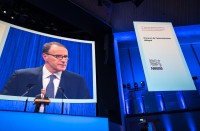
CADARACHE, France (Reuters)– Construction of an experimental nuclear fusion reactor in southern France is in full swing as the cost estimate has ballooned to nearly four times the original estimate, but the ITER project’s new head says new forecasts are realistic.
The seven partners in the International Thermonuclear Experimental Reactor (ITER) – Europe, United States, China, India, Japan, Russia and South Korea – launched the project 10 years ago with a 5 billion euro ($5.6 billion) cost estimate and plans to heat the first plasma by 2020 and achieve full fusion by 2023. By 2011, the budget forecast had swollen to about 16 billion euros.
In May, new ITER chief Bernard Bigot – former head of French nuclear state agency CEA – told a French newspaper ITER would be delayed by more than a decade and incur another 4 billion euros of cost overruns, with the first test of its super-heated plasma not before 2025 and its first full-power fusion not before 2035.
Unlike existing fission reactors, which produce energy by splitting atoms, ITER would generate power by combining atoms in a process similar to the nuclear fusion that produces the energy of the sun.
Laurent Schmieder, head of construction at ITER, said by 2019 the building that will house the so-called tokamak fusion reactor will be complete. The cost of the buildings alone at the complex will be about 2 billion euros, he said.
The challenges of replicating the fusion process on earth are enormous and critics say it remains unclear whether the technology will work and eventually be commercially viable.







